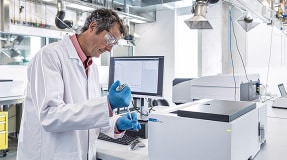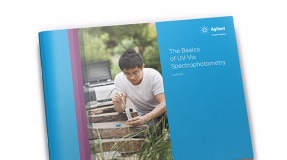
Cary 7000 UV-Vis-NIR Universal Measurement Spectrophotometer
Cary 7000 Universal Measurement Spectrophotometer (UMS)
The Cary 7000 instrument's multiangle specular reflectance and transmittance capabilities allow you to design experiments never before possible—expanding your research—while the automated reflectance and transmission will save you time and money.
- UV-Vis & UV-Vis-NIR Instruments
Request a Quote
Product Details
- Achieve complete sample characterization.
- Measure absolute reflection and transmission in a single sequence—at variable angle and s or p polarization—without moving or disturbing the sample.
- Measure diffusely scattered transmission and reflection at angle, with the freedom to control detector and sample position independently.
- Utilize the huge sample chamber to accommodate all sample types—from small to large—delivering 360 degrees of rotational flexibility.
- Obtain complete control of beam collimation and patch size to match your sample's true end-use conditions.
- Lower your cost-per-analysis, using automation and robotics to save you time and money.
- Measure in minutes what other systems take hours to days to complete—with unattended automation.
- Simply set up your method, collect just one baseline for all angles, insert one or more samples, and walk away.
- New insights into advanced materials with an unprecedented 10 Abs range.
- With 10 Abs range on the base Cary 7000 spectrophotometer, the Cary 7000 UMS ensures you obtain high quality results even with challenging sample measurements, such as high optical density (OD) or under difficult measurement conditions.
- Obtain the highest quality results fast with the next generation Cary WinUV software.
- The Cary WinUV software features a new method editor for simple method setup, advanced data processing, and 3D graphics, ensuring fast and accurate data analysis.
| Control Software |
|
| Depth |
|
| Height |
|
| Light Source |
|
| Maximum Scanning Speed |
|
| Photometric Range (Abs) |
|
| Photometric System |
|
| Power Requirements |
|
| Spectral Bandwidth |
|
| Wavelength |
|
| Weight |
|
| Width |
|
| Z-height |
|
Double Beam Spectrophotometers
Double beam spectrophotometers are fast and accurate, using two beams of light—a sample beam and a reference beam—to correct instrument fluctuations in real-time.
Learn More- Key Literature
-
Cary 7000 Universal Measurement Spectrophotometer
The revolutionary Cary 7000 UMS provides a turn-key solution for your solid sample measurement needs in optics, thin films, coatings, glass, solar, and R&D.
- Brochures
- English
- 13 Jun 2022
- 3.33 MB
Performance of Compact Visual Displays — Measuring Angular Reflectance of Optically Active Materials Using the Agilent Cary 7000 Universal Measurement Spectrophotometer (UMS)
Application note for Performance of compact visual displays — measuring angular reflectance of optically active materials using the Agilent Cary 7000 Universal Measurement Spe
- Application Notes
- English
- 10 May 2021
- 370.14 KB
Near Infrared Photometric Accuracy of Agilent Cary 7000 UV-Vis-NIR Spectrophotometer
Evaluating infrared photometric accuracy of the Agilent Cary UV-Vis-NIR Spectrophotometers
- Technical Overviews
- English
- 14 Jun 2022
- 652.45 KB
- Application Notes
- Brochures
- Catalogs
- Flyers
- Primers
- Technical Overviews
- White Papers
- FAQs
-
FAQ: Cary Win UV cool tricks on Graphics Windows
On most applications, there are some things we can do to make the graphics window look different and sometimes easier to read. This information relates to the use of the SCAN Application, but can also apply to other applications.
FAQ: How to Run Cary UV/Vis Instrument Performance Tests
When necessary, the operator of a Cary UV/Visible instrument can perform tests to access the performance of the instrument and software. The following steps outline execution of these performance tests.
Why Do We Perform a Zero and Baseline in Scan?
The purpose for zeroing is to balance both the reference beam and the sample beam. By adjusting to zero, the instrument readings reflect the absence of sample.
Why is My Cary Spectrophotometer Failing Initialization or Making a Screeching Noise?
Why is My Cary Spectrophotometer Failing Initialization or Making a Screeching Noise?
How Do I Perform a Cary 6x6 Method in Advanced Reads?
How Do I Perform a Cary 6x6 Method in Advanced Reads?
- Instruction Sheets
- Site Preparation Checklists
- User Manuals
More help is just a click away
If you didn't find what you need, try these resources or contact a specialist
White Paper Details Role of Agilent UV-Vis/NIR Spectrophotometers in Advancing Rechargeable Battery Research
Rechargeable batteries are at the forefront of global discussions as an alternative to typical combustion engines. This white paper provides examples of how Agilent UV-Vis/NIR spectrophotometers are being used—by leading research groups—in the characterization of rechargeable battery materials and components.
- 01 Jul 2024
Improving Spectral Quality Using Beam Collimation Control on the Cary 7000 UV-Vis-NIR
In this study, we examined the degree of beam collimation using the Agilent Cary 7000 UV-Vis-NIR spectrophotometer equipped with the Agilent Cary Universal Measurement Accessory (UMA). The various apertures within the UMA improve data quality for determining the edge steepness of an optical filter enabling complete characterization of optical samples. The high f-number apertures of the Cary 7000 ensure superior data quality and accuracy.
- 06 Jun 2024
Color Measurements by Agilent UV-Vis and UV-Vis-NIR Spectrophotometers
Humans perceive color when light interacts with objects using photoreceptors in the eye, primarily through the processes of transmission or reflection. Color measurements using UV-Vis spectrophotometers use the same principle as the human eye. However, UV-Vis spectrophotometers can objectively obtain a value that describes the color by offsetting the color of light used to illuminate the sample. The best choice of instrument for a particular application will depend on sample type and analysis requirements. This white paper describes the options for color measurements that are available from Agilent, including an overview of the Cary WinUV Color application that translates spectral data according to various geometrical coordinates and illumination systems.
- 01 Nov 2023
UV-Vis-NIR Solid Sample Measurement Accessories Guide
Learn about key solid sample accessories for Cary 4000, 5000, 6000i, and 7000 spectrophotometers.
UV-Vis & UV-Vis-NIR Instrument Selection Guide
Find out which Agilent UV-Vis or UV-Vis-NIR spectrophotometer is best for your needs.
UV-Vis Spectroscopy Learning Tools
Get your Basics of UV-Vis Spectrophotometry handbook, and a pack of four undergraduate teaching lab experiments.
UV-Vis Spectrophotometer Applications Overview
A guide to modern UV-Vis spectrophotometer uses, measurement techniques, and their applications.
Christophe Licitra
Research scientist, CEA-Leti, France
"I recommend the Cary 7000 UMS because there is no alignment, no user intervention, no extra baseline, its fully automated and that allows for a streamlined workflow for material characterization”
View MoreDr. Michael K. Trubetskov
Leading Research Fellow, Moscow State University, Russia
"I can recommend this product to all researchers and experimenters who are in a need of high precision and consistent multi-angle spectrophotometric data... This is an invaluable tool for all labs and companies producing multilayer optical coatings for different applications."
View MoreDr. Olivier Muller
Research Scientist, ISL-French-German Research Institute of Saint-Louis, France
"Nothing like the Cary 7000 UMS exists in the marketplace today. It is incredible to be able to do S&P polarized light and R&T at various angles, automated, at the same spot on the sample."
View MoreVideos
- Publications
-
- From gradient-index to step-index filters: A switch between the two types of photonic crystals induced by the amplitude and period of sinusoidal function applied during high-temperature anodisation of aluminium, Grzegorz Szwachta, Blanka Januszewska, Maksymilian Włodarski, Małgorzata Norek, Applied Surface Science, Volume 607, 1 January 2023, 155031 Learn More
- Portable chemiluminescence optical fiber aptamer-based biosensors for analysis of multiple mycotoxins, Yaxue Jia, Siqi Zhao, Dingsong Li, Jinlan Yang, Li Yang, Food Control
Volume 144, February 2023, 109361
Learn More - Optical limiter coatings towards reusable high irradiance shielding, Justin A. Reiss, Michael P. Schmitt, Christopher M. DeSalle, Jake G. Keiper, Patrick E. Albert, Ryan L. Romesberg, Sergei P. Stepanoff, Josie R. Hoover, Dax H. Hoffman, William J. Urmann, Michael E. Zugger, Douglas E. Wolfe, Optical Materials, Volume 133, November 2022, 112989 Learn More



